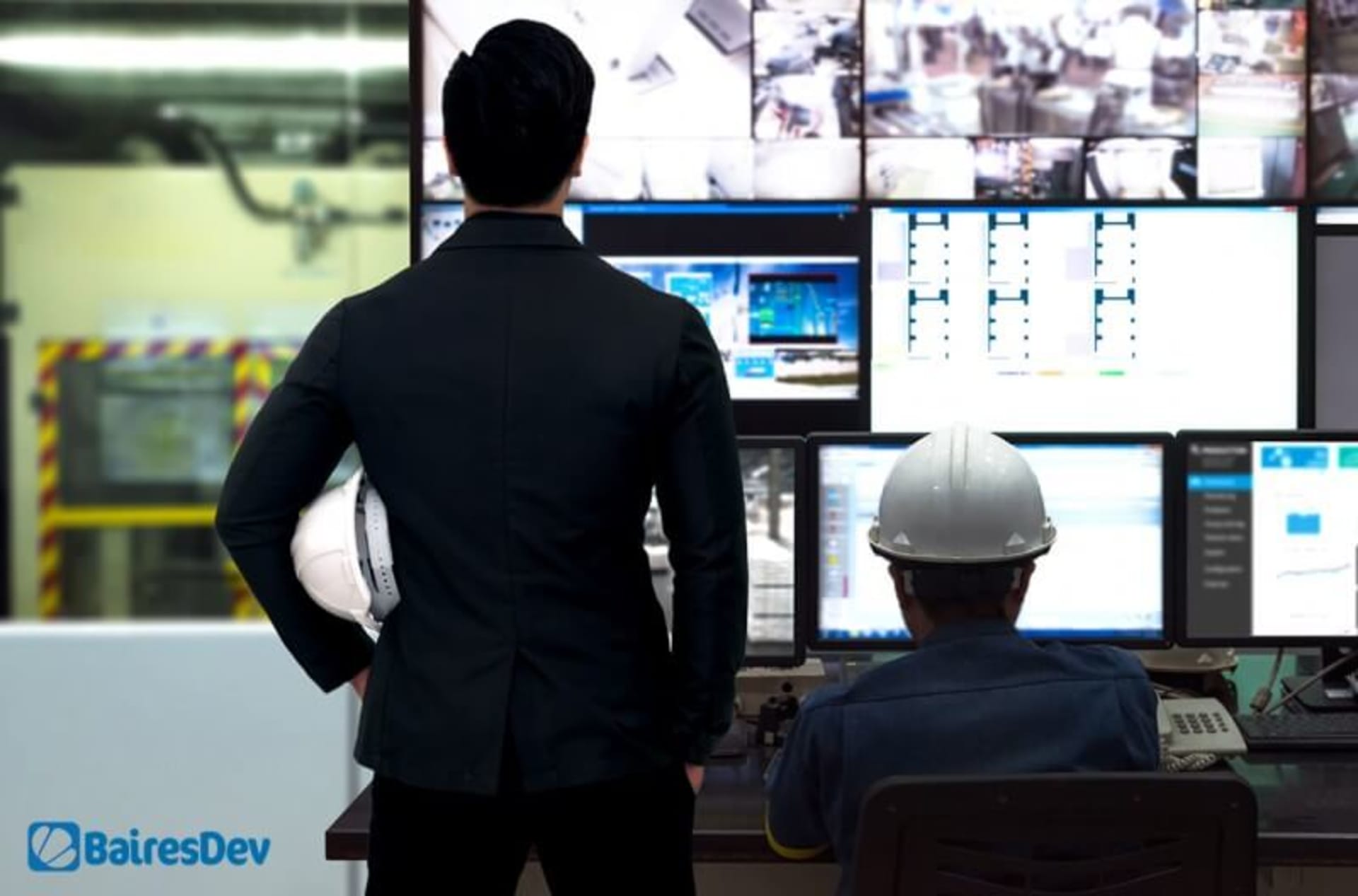Industry 4.0, the new industrial revolution, uses new technologies that change the way machines collect and interpret data. Machines not only require far less human intervention, but they also can communicate with each other for higher productivity levels. The new, smart factory will revolutionize manufacturing, changing the industry completely.
The new era is called Industry 4.0 because it is the fourth industrial revolution. The first industrial revolution came at the end of the 1700s with the introduction of water-and-steam-powered mechanical manufacturing. The second revolution began at the beginning of the 1900s with electrically-powered mass production facilities. Next, the third industrial revolution came around the 1970s with the use of electronics and IT to begin the automation of manufacturing. And now we enter the fourth industrial revolution based on cyber-physical systems.
Industry 4.0 definition
For a factory or system to be considered Industry 4.0, it must include the following:
- Interconnection: The ability of machines, devices, sensors, and people to connect and communicate with each other via the Internet of Things (IoT) or the Internet of People (IoP).
- Information transparency: The transparency afforded by Industry 4.0 technology provides operators with vast amounts of useful information needed to make appropriate decisions. Interconnectivity allows operators to collect immense amounts of data and information from all points in the manufacturing process, thus aiding functionality and identifying key areas that can benefit from innovation and improvement.
- Technical assistance: First, the ability of assistance systems to support humans by aggregating and visualizing information comprehensively for making informed decisions and solving urgent problems on short notice. Second, the ability of cyber-physical systems to physically support humans by conducting a range of tasks that are unpleasant, too exhausting, or unsafe for their human co-workers.
- Decentralized decisions: The ability of cyber-physical systems to make decisions on their own and to perform their tasks as autonomously as possible. Only in the case of exceptions, interferences, or conflicting goals, are tasks delegated to a higher level.
Big data clearly plays an important role in Industry 4.0, and the use of big data enables technologies such as predictive analytics, IoT, AI, and machine learning. These technologies are the driving force behind manufacturing changes.
Technologies Driving Industry 4.0
The adoption of Industry 4.0 is upon us, and as technologies advance so will smart factories. There are specific technologies that are advancing implementation: big data and analytics, IoT, and AI/machine learning are among the most transformative.
Big data and analytics in smart factories
The influx of data has enabled much of the technological upgrades in manufacturing. Companies are collecting more and more data, dubbed “big data.” They can then aggregate and analyze this data to help machines configure and self-diagnose. Big data lends itself to predictive maintenance.
Predictive maintenance is the process of using historical and current data to forecast the condition of a piece of equipment. Essentially, manufacturing parts can monitor themselves and alert a human when a part may be faulty or break down. Smart factories are using predictive maintenance because machines can detect errors that humans cannot see.
Big data allows manufacturers to move away from preventative maintenance, which solves the problem after a malfunction occurs, to predictive maintenance. The data captured enables the implementation of predictive analytics. This means less downtime and a safer workplace.
Example of predictive analytics: food manufacturing
Halts in the production line are frustrating for any manufacturer. However, halts in a food production line can be dangerous. If a part breaks, pieces of the equipment could get into the food. Also, if the production is down for too long, food can spoil. There have been many recalls around the world because of spoiled food originating from manufacturing errors.
Predictive analytics keeps the manufacturing process safer. If a part seems likely to break, it will send an alert to a human that can replace it. This means less downtime and fewer chances of food spoiling. Predictive analytics also helps the environment because it means less food waste and less energy use, as machines do not have to complete the same job twice.
Big data and predictive analytics are just a part of smart factories. Another innovative technology moving this revolution along is the Internet of Things (IoT).
IoT in smart factories
IoT sensors are crucial for smart factories. These sensors, either infrared thermal sensors or vibration sensors, render actions into signals. The signals are then digitally transmitted, and they can then determine the functionality of the equipment in the assembly line.
For example, an infrared thermal sensor can measure temperature. If any equipment becomes too hot, it can send a signal to halt production to inspect what is wrong. Vibration sensors can monitor vibrations and frequencies, which can inspect parts such as motors.
The IoT is also essential for supply chain management. IoT can manage and refill stock, track expenses, and even forecast prices of equipment. IoT can also help manage energy expenses, which are quite high for manufacturers. IoT can track low-performing equipment that uses a lot of unnecessary energy so managers can either replace or fix that part.
Working hand-in-hand with IoT in manufacturing is artificial intelligence (AI) and machine learning.
AI and machine learning in smart factories
AI can help smart factories in many ways. One such way growing in popularity is quality control. The human eye can easily err during the inspection. Therefore, manufacturers are introducing AI capabilities during the in-process inspection. Cameras powered by computer vision algorithms can detect defects immediately and figure out the cause of each problem. Anomaly detection happens in seconds, rather than hours, using AI.
Generative design also relies on AI technology. Manufacturing software development designers and engineers work together to input design goals into generative design software. These goals include cost elements, manufacturing methods, and specific parameters for all materials. The AI-based software then explores all solutions, which would be impossible for humans to do on their own. The software creates design alternatives and uses machine learning to figure out which iteration would work best.
There are numerous benefits to all of these technologies and Industry 4.0, which help manufacturers run safer, more productive, and even cheaper plants.
The Benefits of Industry 4.0
With new technology comes new benefits. Industry 4.0 results in increased productivity, safer work environments, and reduced costs.
Better maintenance and reduced costs
Poor maintenance can reduce the manufacturing plant’s productivity from 5-20%. And, downtime costs U.S. manufacturers roughly $50 billion USD each year. It’s no wonder plant owners are eager to adopt this new technology. The technology is becoming more affordable. Bandwidth fees, storage, and network costs are all coming down. The ability to predict when a part will malfunction saves time and resources and keeps productivity high. Machines are simply more reliable in Industry 4.0. This reduces maintenance costs and downtime.
Data-driven decisions
Manufacturing plants can rely on data instead of human instinct. Decisions can arise from looking at pure facts. Executives can make data-driven decisions on the manufacturing process, ushering in a new way of doing business.
Now that the benefits of Industry 4.0 are clear, it’s time to understand where outsourcing fits in this new revolution.
Role of Outsourcing in Industry 4.0
Outsourcing will likely play a significant role in Industry 4.0. The skills gap and talent shortage, combined with the benefits of software development outsourcing, prove this to be true.
Talent shortage for Industry 4.0
The global engineering services outsourcing market will reach $2 Trillion by 2026. Engineers are crucial to the development of Industry 4.0. There is a global talent shortage of engineers qualified to help with this growth. The solution is outsourcing engineering services to firms and individuals who can meet these skills demand.
Software development outsourcing benefits
Outsourcing is on the rise mainly because of the numerous benefits it provides. Companies invested in Industry 4.0 can drastically reduce logistics costs. Outsourcing provides a cost-effective way to create Industry 4.0 technology.
Industry 4.0 is an innovative revolution. Outsourcing provides new, unique talent that can improve upon existing technology. Skilled developers can provide the insight necessary to fulfill manufacturing requests.
Qualified developers are now worldwide, thanks to globalization. Companies that work in Industry 4.0 should be sure to look outside of the United States for talent. Thanks to outsourcing hubs across Latin America, geographical boundaries are no longer an issue. Companies can work with developers in the same time zone, efficiently communicating their needs. Given these benefits, it’s clear that outsourcing will play a big role in the advancement of Industry 4.0.
Investing in Industry 4.0
An Accenture report claims Industry 4.0 could add $14.2 trillion to the world economy over the next 15 years. Furthermore, Markets and Markets say manufacturers will spend $74.8 billion per year on smart factory technology by 2020. And McKinsey estimates that the total economic impact of smart factories could potentially reach $3.7 trillion per year by 2025.
Smart factories rely on smart technology. And smart technology relies on talented engineers. Outsourcing will play a crucial role due to its benefits.
Thinking further into the future, experts are already forecasting Industry 5.0, which relies on personalization. Industry 5.0 will allow customers to customize what they want. While we are not quite there, it’s worth thinking about the role technology will play. Both Industry 4.0 and Industry 5.0 will require qualified engineers. This talent is now worldwide, and outsourcing firms lead the way in discovering this talent.
The benefits of Industry 4.0 are clear. Businesses are now investing heavily in these technologies to stay ahead of the competition and get to market faster. Big data, IoT, and AI will have a revolutionary impact on the manufacturing industry, making it clear why companies around the globe are scrambling to innovate in this industry.






